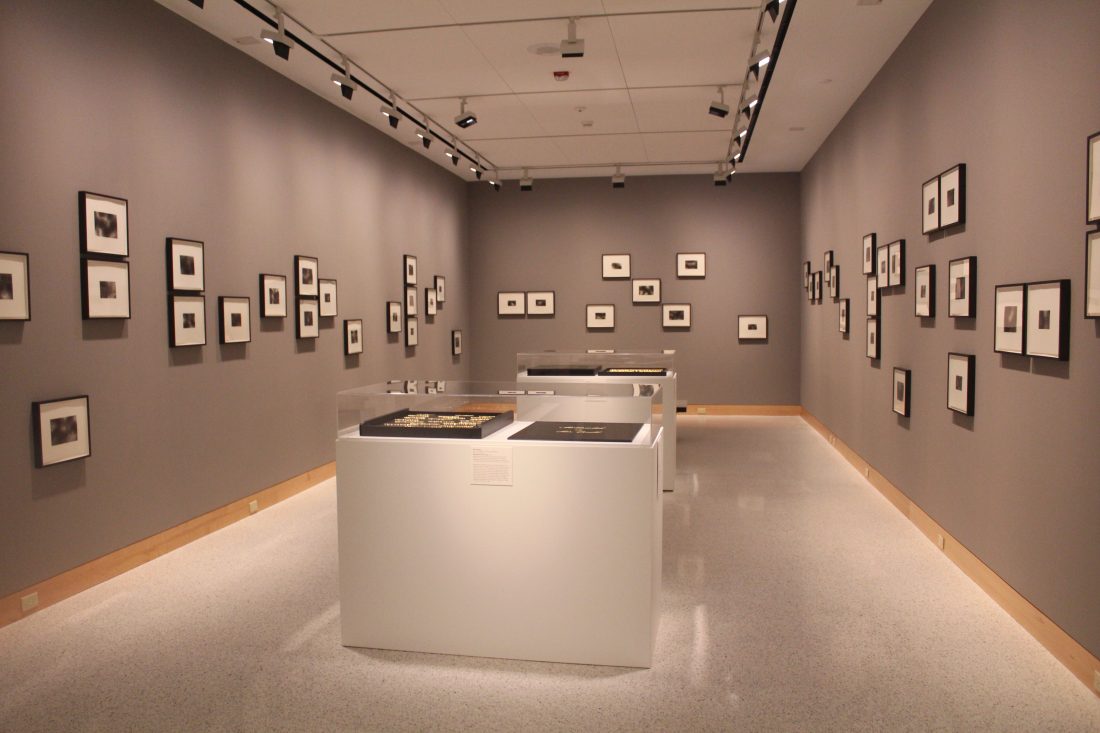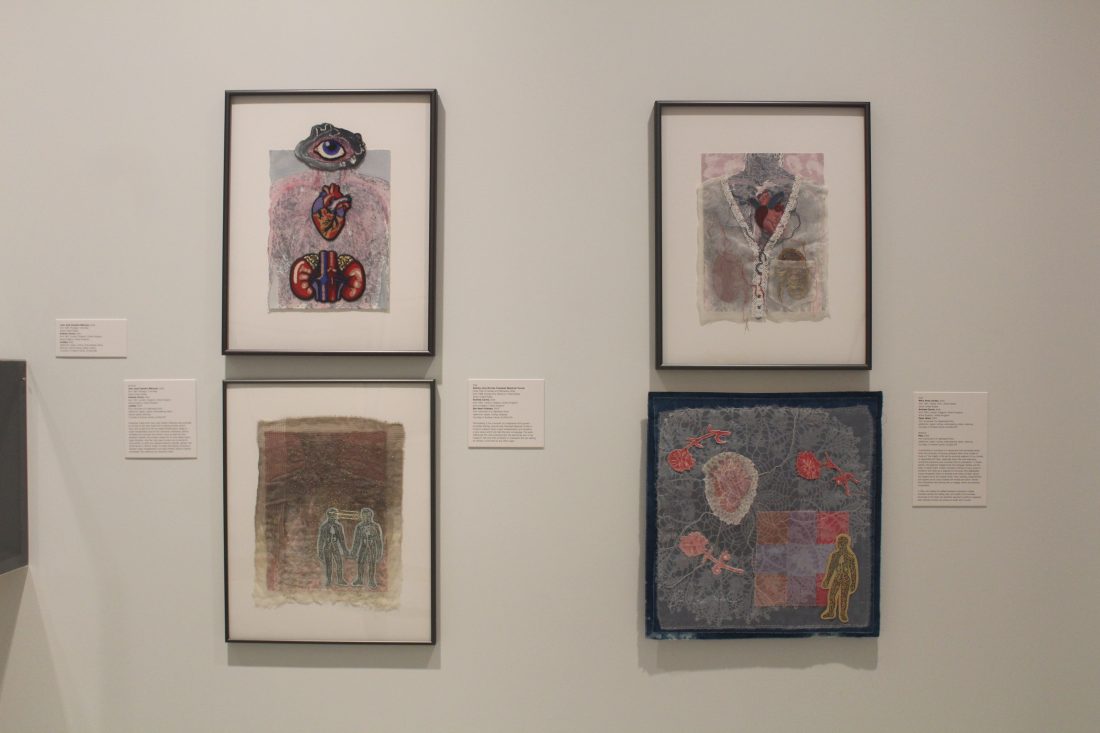‘Healing, Knowing, Seeing the Body’: Spencer Museum exhibit offers artists’ takes on health, the body

photo by: Lauren Fox
The Spencer Museum of Art at the University of Kansas is pictured on April 21, 2021.
Cassandra Mesick Braun could not have predicted in 2017 that the health-centric art exhibit she was curating would come to fruition during a pandemic.
But four years later and one year into the COVID-19 crisis, her exhibit on display now at the Spencer Museum of Art, “Healing, Knowing, Seeing the Body,” exemplifies that art is always relevant to the human experience.
In a time when bodies are “under constant threat” due to the pandemic, Mesick Braun and the team at the University of Kansas museum are inviting visitors to engage with art that contributes to the understanding of the human body.
“The themes in the show are even more powerful than they would have been when we weren’t in the middle of a global pandemic — in a moment where we’re all very aware of our bodies and illness and healing,” said Elizabeth Kanost, the Spencer Museum’s director of external affairs.
Mesick Braun said she hopes visitors will engage with the artwork by having discussions about how bodies can serve as universal points of connection, as well as think critically about how bodies have been a means of distinguishing and alienating people. She also said the exhibit is meant to engage people with healing traditions from other cultures. Mesick Braun is a curator with the Spencer Museum of art who specializes in global indigenous art.
The exhibit is divided into three broad topics: healing, knowing and seeing.
Healing
In the healing section, the first room visitors encounter, Mesick Braun said most of the art concerns approaches to illness and alleviating pain, as well as topics such as mental health, infectious disease and pandemics.
A piece by Dylan Mortimer called “View from the Ambulance” shines and sparkles along the right side wall. Many of Mortimer’s pieces are inspired by his experience having cystic fibrosis and a double lung transplant. “View from the Ambulance” depicts ambulance doors and a pair of Nike Air Max shoes. According to Mesick Braun, the artist said that when he was a child he wanted a pair of those shoes — as well as the air contained in their soles.
“As a cystic fibrosis patient, the air was as inaccessible to him as the coveted shoes themselves,” she wrote in an email to the Journal-World.

photo by: Image courtesy of Dylan Mortimer
Dylan Mortimer, “View from the Ambulance,” 2018
The “healing” section also features a commissioned piece from artist Ingrid Bachmann called “Embrace.” The installation is made of felt and copper, among other materials, and includes occasional sounds from speakers that are meant to evoke serenity. Bachmann’s installation is one of two commissioned pieces for the exhibit, which includes over 150 pieces of work from the Spencer’s collection as well as loans from other institutions.

photo by: Lauren Fox
Ingrid Bachmann’s installation “Embrace” is featured in the foreground and against the left wall in this photo. Her piece was originally meant to be arranged differently, Cassandra Mesick Braun said, but due to COVID-19 Bachmann proposed breaking the installation into two separate pieces. Mesick Braun said an unintended consequence of that decision was that viewers can now think about connection across distances in regard to the piece.
Knowing
The “knowing” section of the exhibit reveals the role art plays in contributing to knowledge of the human body.
A series of pieces in the “knowing” section are collaborative works done by members of the KU community and Andrew Carnie, an artist based in the United Kingdom. Carnie is interested in the non-medical effects of organ transplantation, and his artwork explores topics such as anonymity, consent and responsibility.
Just as organ recipients do not know from whom their organs came, Carnie sends his artwork to an intermediary — in this case, Mesick Braun — who then gives his pieces to other artists who add to his work. He calls the series “Junctures of a Haphazard Kind.” KU professor Mary Anne Jordan and KU alumni Juan José Castaño-Márquez, Nazanin Amiri Meers and Sydney Jane Brooke Campbell Maybrier Pursel contributed to Carnie’s watercolor pieces by adding their own artwork, such as beadwork or embroidery, on top. They will participate in a virtual event on May 1 with Carnie through the Spencer Museum.

photo by: Image courtesy of Andrew Carnie and Sydney Jane Brooke Campbell Maybrier Pursel
Andrew Carnie and Sydney Jane Brooke Campbell Maybrier Pursel, “Eye Heart Kidneys,” 2020
Seeing
The “seeing” section of the exhibit focuses on the history of humans observing their bodies and anatomical illustrations, Mesick Braun said. The section includes a series of photographs of the bodies of HIV-positive individuals taken by Jon O’Neal, as well as self-portrait drawings by Elizabeth Layton, popularly known as Grandma Layton.
The room also includes a series of prints of pulse waves from Dario Robleto called “The First Time, The Heart: A Portrait of Life, 1854-1913.” Robleto chose to focus on records of pulse waves from the late 19th and early 20th century that were not about disease, but rather recorded during everyday circumstances. The prints include descriptions of the circumstances, such as “smelling lavender,” “being shamed/scolded,” “full meal with wine” and more. Huascar Medina, the poet laureate of Kansas, worked with Robleto to organize the prints so that the descriptions read as poetry.

photo by: Lauren Fox
Artist Dario Robleto’s prints of pulse waves recorded between 1854 and 1913 are hung on the walls of this room in the “Healing, Knowing, Seeing the Body” exhibit at the Spencer Museum of Art.
Available for view through May 16
Kanost, the museum’s director of external affairs, said the Spencer Museum was excited to be welcoming people back and creating a safe environment in which to view artwork.
“I think people will like being able to come and see work that relates to their body that doesn’t maybe stress them out,” she said. “Coming here to have a moment of relaxation in a place where they can feel as safe as possible and reflect and just have a moment of inspiration and respite.”
“Healing, Knowing, Seeing the Body” runs through May 16. The Spencer Museum will close on May 17 and will not reopen until the fall, while renovations are made to the fourth floor. Kanost said the third floor of the museum will reopen in the fall, but the fourth floor, which holds the museum’s permanent collection, likely will not reopen until the summer of 2022. When the fourth floor is reopened, the exhibits will be installed in a new way, so visitors only have a few weeks to experience the museum in its current form.
“We really want people to come in before we close in May so that they can experience those galleries one last time before they completely change,” Kanost said.
The Spencer Museum is open Thursdays through Sundays from 1 to 5 p.m. The museum will offer extended hours until 8 p.m. on May 6, 7, 13 and 14. To plan a visit, make a free reservation by going to spencerart.ku.edu/plan-your-visit.

photo by: Lauren Fox
Clockwise from top-left are Andrew Carnie’s pieces with collaborations from Sydney Pursel (“Eye Heart Kidneys,” 2020), Mary Anne Jordan (“Open Heart,” 2020), Mary Anne Jordan (“Plea,” 2020) and Juan José Castaño-Márquez (“untitled,” 2020).

photo by: Image courtesy of the Spencer Museum of Art, University of Kansas
Dario Robleto, “Being shamed/scolded (you behave like a child; you ruin everything for me.), 1876,” 2017







